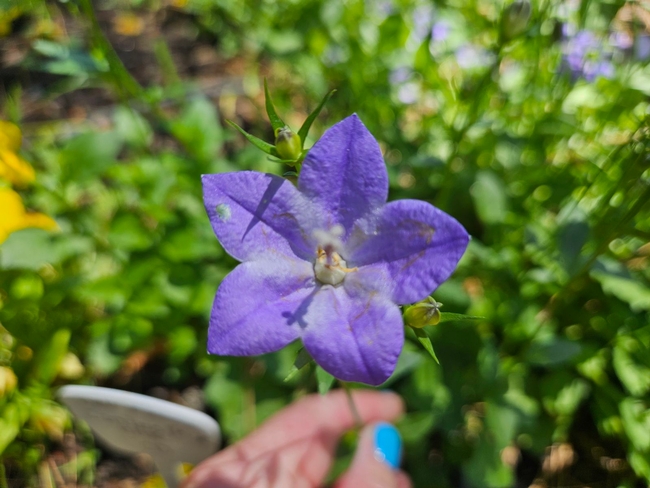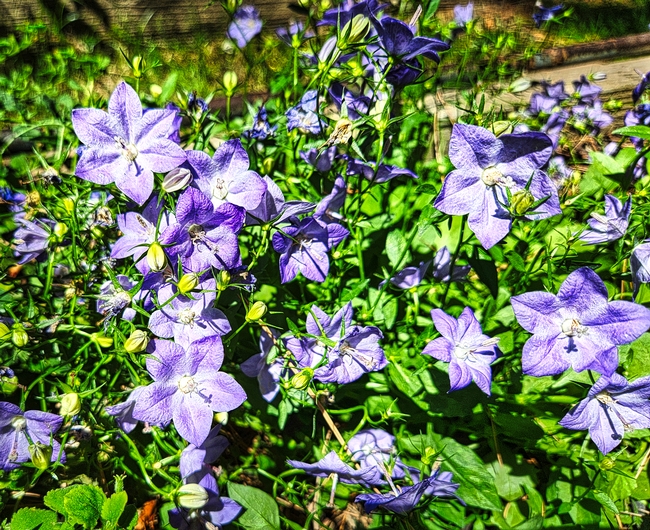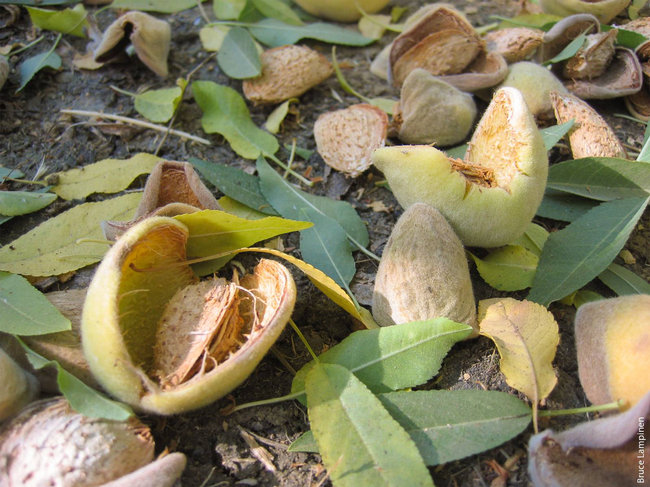UC Blogs
Why These Moths Are Unwanted
As we gather to celebrate moths during National Moth Week (traditionally held the last full week in July and to be observed areawide on Saturday...
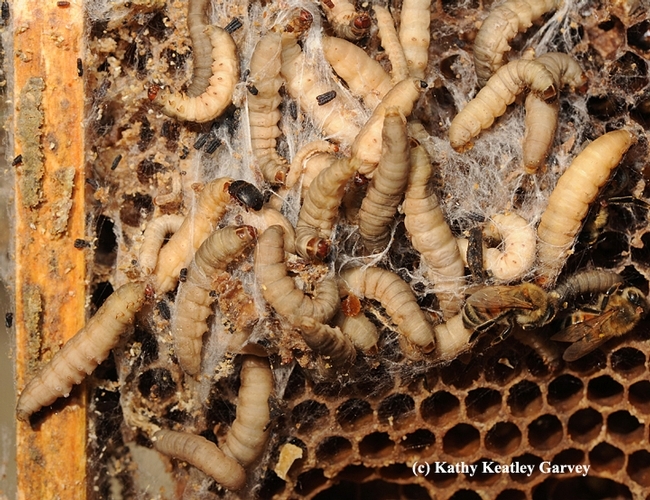
Close-up of the larvae of the greater wax moth (Galleria mellonella), pests of honey bee colonies. Also shown is another bee colony pest, a hive beetle. (Photo by Kathy Keatley Garvey)
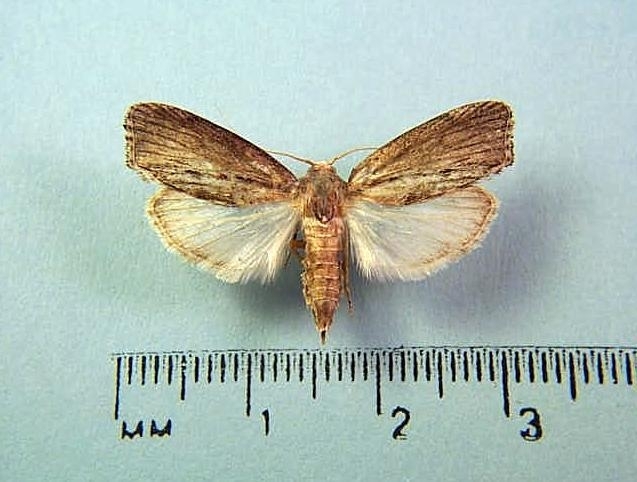
This is the greater wax moth (Galleria mellonella) from the Bohart Museum of Entomology Lepidoptera collection. (Photo by Jeff Smith)
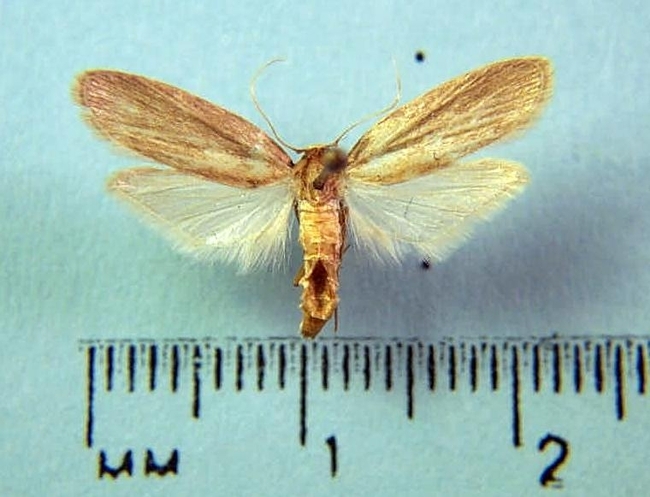
This is the lesser wax moth, Achroia grisella, from the Bohart Museum of Entomology Lepidoptera collection. (Photo by Jeff Smith)
Stunning Surprise Blooms in the Garden
A couple of years ago, my husband and I decided to convert one of our raised garden beds into a pollinator patch. When we began searching for plants to consider for this space, I was so excited to see that there was a sale at the UC Davis Arboretum and Public Garden (https://arboretum.ucdavis.edu/plant-sales). The plants offered for sale in the garden are grown at the nursery and are well adapted to the local climate, so I was confident that all of my choices would settle well in my garden project.
Many of the plants that we chose were not flowering, but there were photos of what to expect when in full bloom. I always enjoy doing some online research when in midst of a project and I had a bundle of new plants to investigate before planting. I was able to find detailed specifications of each plant, such as the expected height, width, bloom color and texture. This information helped me plan on where to plant in the garden for a color balance.
We watched the pollinator garden grow and develop very healthy foliage. However, we did not have many blooms until just this summer, and what a stunning surprise of color! Our flowers were much more vibrant than what we imagined from photos.
There is one plant that stands out, and it seems to have bloomed overnight, popping with many bell-shaped lavender flowers. This beautiful plant is called Bellflower, Campanula. (Campanula is Latin for “little bell”). The variety we have is calledCampanula 'Cariboo'- BlueBellflower.
This bellflower is a perennial and remains short between 14 and 18 inches, but will spread over the garden. I think it makes a perfect plant for containers, rock gardens, edging, mass plantings, and ground cover. This plant is beneficial for pollinators, will bloom from late spring to late summer, and thrives in full sun or half shade. The plant can handle a clay soil type, and water needs are minimal.
While doing research, I found that there are a number of other bellflower varieties available, such as Wilkins Harebell Campanula wilkinsiana,or theDesertbells Phacelia campanularia. So, there are wonderful choices and colors to consider for your own garden. We love how our seasonal garden turned out and are happy to watch the pollinators doing their thing!

Bellflowers in the Garden - front left - Al Alvarado

Bellflowers in the Garden 2 - Al Alvarado
'Let's Go Mothing' on July 20 at Bohart Museum of Entomology
Let's go mothing! What's mothing? The National Moth Week website describes mothing as "a hobby for nature enthusiasts who use light or...

This colorful moth is Arctia virginalis, Ranchman's tiger moth, a diurnal or day-flying moth commonly known as the Ranchman's tiger moth. In its larval stage, it's a wooly bear caterpillar, commonly found at the Bodega Marine Reserve and on the trails of Bodega Head, Sonoma County. (Photo by Kathy Keatley Garvey)

This is California Pyrausta Moth (Pyrausta californicalis), commonly known as "the mint moth." It feeds on plants in the mint family, including spearmint and peppermint. (Photo by Kathy Keatley Garvey)

This is a pterophorid plume moth (family Pterophoridae). The "T-square" shape is classic. (Photo by Kathy Keatley Garvey)

This is a white-lined sphinx moth (Hyles lineata), which flies during the day and night. (Photo by Kathy Keatley Garvey)
Jeff Smith: Busy as a Bee? No, As Industrious as a Lepidopterist
Busy as a bee? No, as industrious as a Lepidopterist. Specifically, as industrious and dedicated as Jeff Smith, curator of the moth and...

Jeff Smith, curator of the Bohart Museum of Entomology's Lepidoptera collection, chats with visitors at an open house. (Photo by Kathy Keatley Garvey)

Legendary Lepidopterists Paul Opler (left) and Robert Michael Pyle, founder of the Xerces Society for Invertebrate Conservation, chat during the international Lepidopterist Society’s 68th annual conference (2019) that included visits to the Bohart Museum. Opler, who died last year, considered the Bohart Museum Lepidoptera collection "The Bold Standard" of Lep collections. (Photo by Kathy Keatley Garvey)
New project aims to use farm waste to fuel bioeconomy
UC ANR to help create database, support technology for sustainable bioproducts and biofuels
In California's Northern San Joaquin Valley, crop leftovers such as almond shells, fruit peels and orchard trimmings can potentially be converted into sustainable bioproducts and biofuels – with the right technology. The philanthropy Schmidt Sciences' Virtual Institute on Feedstocks of the Future, which supports replacing fossil feedstocks with renewable biomass sources, has awarded new funding to a group investigating how to make better use of the diverse agricultural waste in the region.
“This is an important project for California as it quantifies the diverse ‘ingredients' in the North San Joaquin Valley available to fuel the emerging biomanufacturing industry in the state,” said Gabe Youtsey, chief innovation officer for the University of California Agriculture and Natural Resources. “This foundational work will kickstart a completely new innovation bioeconomy in the Central Valley that will create new high-paying jobs for our communities and support a resilient food and agriculture industry through circular biomanufacturing.”
Circular biomanufacturing is a process that uses waste streams as raw materials to create new products.
“Circular means taking waste streams from agriculture such as almond shells or grape pomace, forest waste or food processing waste and using that material as the ‘feedstock' in a fermentation tank to create new bioproducts,” Youtsey explained.
The group, “Building the Circular Bioeconomy in the North San Joaquin Valley” or BioCircular Valley, is co-led by the Department of Energy's Lawrence Berkeley National Laboratory (Berkeley Lab), UC Berkeley, and BEAM Circular, with partners at UC Merced, UC Agriculture and Natural Resources, the Almond Board of California and USDA Agricultural Research Station in Albany.
“California has this incredible diversity of materials, but they aren't well understood – and this makes it difficult to know how to extract the most value out of them,” said Corinne Scown, a senior scientist at Berkeley Lab and UC Berkeley and one of the project leads. “We want to characterize them and make that information available so companies can more easily figure out which feedstock is a good match for them, and then use that agricultural residue to make everything from bio-based polymers and chemicals to sustainable materials and aviation fuels.”
One of the group's goals is to build a publicly accessible database and user-friendly map full of information about different feedstocks, the raw plant materials and biomass that can be broken down and used to make bioproducts. That includes where feedstocks are located, when they are available, how they are currently disposed of, how they perform in different bioreactors, how much sugar or lignin they contain, whether they can be processed with other feedstocks, their greenhouse gas footprint, the potential cost, and much more.
UC ANR's role is to collect data on available feedstocks from forest, agricultural and food processing byproducts, as well as municipal waste streams through sampling and observation.
“We will do this through the extensive knowledge and relationships we have with the California agriculture industry in the North San Joaquin Valley,” Youtsey said. “UC ANR will also support industry outreach as new ‘conversion' technologies are developed, to pilot them with California growers and processors.”
The project will also test ways to improve the flexibility of the conversion process, which breaks down feedstocks to prepare them to make bioproducts. Researchers will apply artificial intelligence to their lab-generated data to improve predictions of how feedstocks can be processed most efficiently or blended together. Being able to use the same technique on different (or mixed) kinds of plant matter would open up ways for companies to make bioproducts more easily.
“Our region has a fantastic combination of diverse and large-scale agricultural activities alongside manufacturing expertise, making this a great place to scale up bioeconomy innovation,” said Karen Warner, CEO of BEAM Circular. “This project will allow us to reduce barriers to using our region's abundant waste streams in more sustainable and valuable ways, so that we can create the products that people need with renewable inputs that are better for the planet.”
The project builds on ongoing efforts to establish biomanufacturing capabilities in the northern San Joaquin Valley, which includes San Joaquin, Stanislaus and Merced counties. Providing better data on how to convert the valley's millions of tons of agricultural waste into valuable products may spur biomanufacturing companies to build facilities nearby, minimizing how far the raw materials have to be moved and generating new jobs.
“This project is designed to benefit a region that has massive potential, but so far has been economically left behind, and to develop a new industry that can provide improvements in air quality, water quality and greenhouse gas emissions as well as significant opportunities in economic equity and the creation of new jobs,” said Blake Simmons, director of Berkeley Lab's Biological Systems and Engineering Division and the BioCircular Valley project lead.
“This kind of research started as basic science, and now we're bringing information and solutions to people who can use them. And the knowledge generated through this project will advance not only the ability of the NSJV to make use of its own regionally available future feedstocks, but will also accelerate the understanding of feedstocks relevant across California and across the U.S.”
The new funds for the project come from the Virtual Institute on Feedstocks of the Future, a partnership between Schmidt Sciences and the Foundation for Food & Agriculture that supports collaboration on research to transform biomass into alternative feedstocks for biomanufacturing. The award is one of five announced today, which total $47.3 million over five years. It is expected that the five teams will collaborate to share best practices and knowledge to boost the bioeconomy at the national level.
“We are grateful for Schmidt's generous support that will help deploy advanced technologies on the ground,” said Alicia Chang, interim president of Berkeley Lab Foundation. “The foundational research and expertise developed through work for the Department of Energy sets the stage for this team to apply their capabilities to bring jobs and lift the community and the economy in the Northern San Joaquin Valley.”



